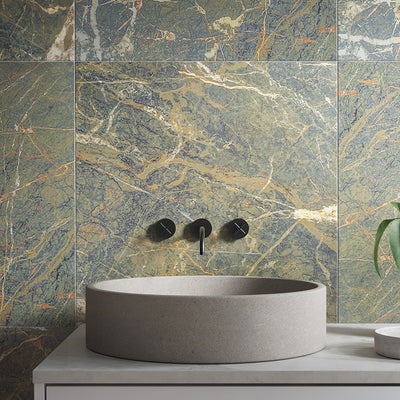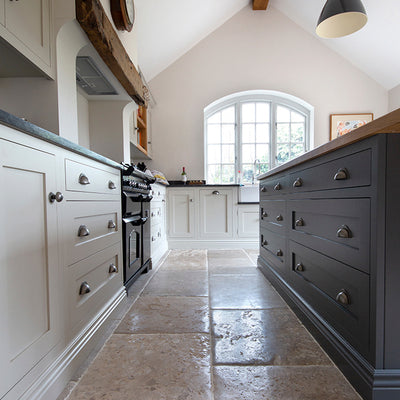A familiar question we are asked when speaking to customers is ‘what is the difference between porcelain and ceramic tiles’. Whilst the majority of our range is porcelain, both materials are available out there in the market and it is helpful to understand the difference. There has often been a confusion surrounding the two materials, and so this post very simply covers the few key indicators of the difference, as well as things to consider when choosing stone effect or wood effect tiles.
How are porcelain tiles made?
A porcelain tile is a man-made product that combines kaolin (white) clay, finely ground sand and feldspar. The clay mixture of porcelain is fired to an extremely high temperature (upwards of 1200 c) resulting in a very dense and hardwearing tile.
How are ceramic tiles made?
Ceramic tiles are also man-made made of natural red or brown clay. The mixture is also fired at a high temperature but lower than that of porcelain which makes them a little less dense than a porcelain.
Water absorption
Porcelain tiles benefit from a low water absorption rate – typically this stands at 0.5% or less. This means they are much more resistant to water and less porous than a ceramic tile where water absorption rates are higher.
How to tell the difference
One noticeable difference between porcelain and ceramic tiles is the colour of the body itself (underneath the print or glaze). Porcelain is colour-bodied meaning it is very similar to the tone of the print itself, whereas ceramic is usually brown or red in colour, or white bodied. One important thing to note on this is that if you were to ever chip a tile (say with the edge of a cast iron pan) the colour would show through, whereas a porcelain tile would be much less noticeable. Most decorative ceramics are white bodied which is less obvious than a red body ceramic.
PEI Rating
A PEI rating (Porcelain Enamel Institute) is given to most porcelain or ceramic tiles and is a helpful and easy way to check which tile is suitable for your home or space, dependant on the amount of footfall the tiles will see.
PEI 0 - No foot traffic (wall tiles only)
PEI 1 - Very light traffic (e.g. en suite)
PEI 2 - Light traffic (e.g. bathroom or bedroom)
PEI 3 - Light to moderate traffic (suitable for most domestic floors)
PEI 4 - Moderate to heavy traffic (suitable for domestic floors and some commercial use)
PEI 5 - Heavy traffic (suitable for all domestic and commercial uses with heavy footfall)
Most ceramic floor tiles sit within 3 to 4 and porcelain tiles usually have a rating between 3 and 5. We state the PEI rating on all our product pages under 'product details'.
Cost
When it comes to the difference in cost of both materials, in general, red body ceramics tends to be cheaper in price, making it a great budget option but still offer a hardwearing tile suitable for indoor residential usage. Porcelain tiles tend to cost slightly more due to their stronger characteristics and differences. White body ceramics tend to sit at a similar price point to porcelain alternatives.
Suitability and uses of porcelain and ceramic
Depending on the room or space you are wanting to tile, may depend on whether one or the other is the best option. Ceramic tiles are only suitable for indoor use and are particularly popular as wall tiles or areas with less footfall. There are many smaller-format tiles that tend to be ceramic, with options of gloss and crackle glazes, as well as patterned. Porcelain has a big advantage of being suitable for indoors and outdoors, lending itself well as a floor tile. It is worth noting the ‘R’ rating of a tile (a measurement for slip resistance) – most indoor porcelains tend to be R9 or R10, whereas for external use, we advise an R11 (grip) tile. All our outdoor porcelain paving is R11.
Outdoor porcelain patio tiles
Porcelain is a popular material as outdoor porcelain paving because of its frost resistance, UV stability and slip resistance (R11 tile). Its low water absorption rate means it is a wonderful choice for a patio tile and will weather every season. Porcelain paving is also available in a variety of shades and consistent tones to suit your garden space.
FAQ’s
1. Should I choose porcelain or ceramic tiles?
Ultimately, this decision lies with where the tiles are going to be installed. If external, then only a porcelain tile would be suitable. If internal, both ceramic and porcelain can be installed. Porcelain will be a more durable floor tile due to the high temperature it is fired at during the production process. Ceramic tiles are still very hardwearing, although they are slightly more water absorbent and are often red bodied. If you are looking for an internal tile on a tighter budget, then ceramic tiles are likely to be the best choice. Ceramic tiles are often smaller format such as patterned wall tiles.
2. Can porcelain and ceramic tiles go outside?
Porcelain is suitable for outside (using a tile with the correct ‘R’ rating and installation). Matching indoor, outdoor porcelain tiles are increasingly popular choices with a wide range of tones and styles and their low water absorption. Unfortunately, ceramic tiles are not suitable for external use.
3. Is porcelain and ceramic easy to clean?
Yes, both porcelain and ceramic tiles are very simple and easy to clean. They both require low maintenance and benefit from stain resistance, scratch resistance and UV stability, meaning the tiles will not stain, scratch, or lighten overtime. Regular maintenance includes sweeping or vaccuming and mopping occasionally with a porcelain friendly cleaner. Porcelain also has a very low water absorption, making them nearly waterproof.
4. Do I need to seal or treat the tiles?
In most cases, porcelain and ceramic tiles do not require sealing and are very forgiving. Some porcelains in gloss finishes may need sealing, as well as crackled ceramic tiles – we advise on every product page if a tile requires sealing, and most companies should be able to advise you on this.
5. Are porcelain and ceramic tiles suitable for underfloor heating?
Yes! With the correct installation, all our tiles are suitable for underfloor heating. We advise using an anti-fracture matting when installing the tiles, and discussing any specific substrate or installation requirements with your installer.






